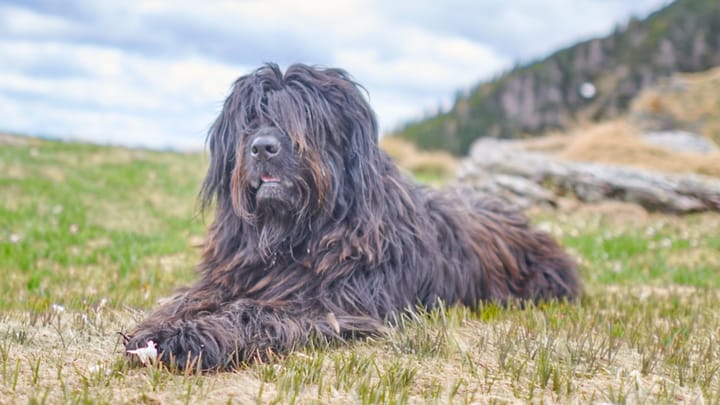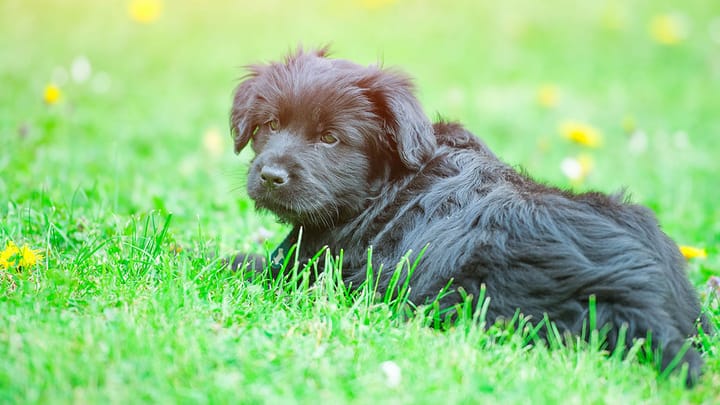Bergamasco Shepherd Dog
Other names : Bergamasco, Cane da pastore Bergamasco, Knut


The forerunner of the Bergamasco breed originated in Persia (yesteryear Iran) and was brought westwards by migrating farmers and societal drift. Since its conception in the mid-1800s the breed has been used for herding and roving. The dog is extremely rare in the UK: ten years ago it was estimated that only 30 such dogs were native to the British Isles.
|
Life expectancy |
The Bergamasco Shepherd Dog has a life expectancy of between 13 and 15 years |
|
Temperament |
|
|
Size |
Large
|
|
Adult size |
Female
Between 21 and 23 in
Male
Between 23 and 24 in
|
|
Adult weight |
Female
Between 57 and 71 lb
Male
Between 71 and 84 lb
|
|
Coat colour
The Bergamasco is only found of black or grey colours. The black coat tends to bronze in the sun. |
Sand Brown |
|
Type of coat
The double coat is long and actually consists of three types of fur: the undercoat, the top coat and the goat hair. |
Long |
|
Eye colour
Dark brown or chestnut. |
Brown
|
|
Purchase price |
The Bergamasco Shepherd Dog costs between £700 and £1 |
The coat of the Bergamasco is self-cleaning. As a result of this, the dog should only be bathed once or twice a year. The exception to this rule would be if the dog needed to be cleaned for some reason. Cutting or over-grooming this dog’s coat can cause the dog to develop skin infections and irritations.
More details about the Bergamasco Shepherd Dog
Bergamasco Shepherd Dog: Origins and history
The ancestor of the Bergamasco came from Persia. According to students of canine heritage such a dog may have existed more than seven millennia ago. It migrated westwards amid centuries of societal shifting to find its more recent home (1850s) in the Italian Alps near the town of Bergamo. Genetic ‘paw-printing’ shows that it was around this time that the first Bergamasco was born.
Physical characteristics of the Bergamasco Shepherd Dog
A medium-sized dog with an abundant matted coat. The dog is stocky and sturdy; its body is almost square in appearance. The muzzle is rather flat and broad leading to a gradually sloping stop and upwards to a medium-sized and reasonably flat skull. The ears are set high and drop but are not flat against the cheek.
FCI classification of the Bergamasco Shepherd Dog
-
Group 1 - Sheepdogs and Cattledogs (except Swiss Cattledogs)
-
Section 1 : Sheepdogs
Bergamasco Shepherd Dog: Characteristics
Bergamasco Shepherd Dog: Behaviour
Training a Bergamasco Shepherd Dog
A strong-willed animal is the Bergamasco and one that is not easy to train. Being independent the Bergamasco will learn when it wants to learn and when. The Bergamasco requires a stronger-willed leader who is confident and consistent.
Bergamasco Shepherd Dog: Lifestyle
Breed compatibility Bergamasco Shepherd Dog
Bergamasco Shepherd Dog: Purchase price
The price of purchase for a Bergamasco Shepherd puppy is between £700 and £1,000. It will cost approximately £80 to £120 per month to keep this dog.
Bergamasco Shepherd Dog: Shedding
None
The Bergamasco coat is considered to be non-shedding and ‘hypoallergenic’.
Bergamasco Shepherd Dog: Grooming
The Bergamasco’s coat changes in texture and quality throughout the dog’s early years; it is worthwhile to read a more comprehensive account of how to treat the dog’s coat. By the time the coat is fully-formed (when the dog reaches 3 years old) it should be left ungroomed.
Bergamasco Shepherd Dog: Health
Having been successfully bred for centuries the Bergamasco is generally healthy and robust. Its life expectancy is 13 to 15 years.
This particular breed of sheepdog is one of the hardiest.
Due to the insulating quality of the coat, the Bergamasco will tolerate hot weather but still needs an abundant supply of fresh water during the summer months.
The double coat of the Bergamasco keeps the dog warm even when walking in the rain and snow.
Weight gain can be a feature of the Bergamasco. If your Bergamasco is not exercised as regularly as it should be and is fed too much human or substandard food it will become obese.
- Hip dysplasia
- Eye issues
- Obesity
- Bloat/gastric torsion
Do you want a Bergamasco Shepherd Dog dog ?
Oh no...
There are no Bergamasco Shepherd Dog adoption profiles at the moment...






